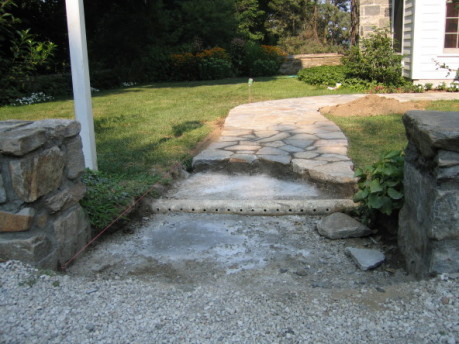Re-posted from August, 2005
 I will not defy the copyright to post the New Yorker cartoon in which a scholarly, bored-looking gent in his armchair tosses his half-read book over his shoulder, with the caption "The man who knew enough."
I will not defy the copyright to post the New Yorker cartoon in which a scholarly, bored-looking gent in his armchair tosses his half-read book over his shoulder, with the caption "The man who knew enough."
The immediate issue is whether you know enough about cement and concrete. Here are some facts, with some links to read more.
Cement is the glue of concrete, which is a sort of man-made sedimentary rock. When an "aggregate" or "filler" such as sand, gravel, etc is added to cement, plus water, it's called concrete, or mortar when the aggregate is fine sand.
Cement is produced by heating - burning - limestone and clay. The addition of a little gypsum at the end makes "Portland Cement," which is what all cement is nowadays. The trace of gypsum slows the curing, so it can be worked with more easily.
Water is a critical ingredient of the final product, not just to make a usable mix, but as an actual ingredient of the chemistry of solid concrete, which is a (non-organic) hydrate. Thus, during curing, concrete likes some splashes of water from hose or rain to gain maximum durability. (Thus cement doesn't "dry", it "cures".)
Concrete takes 28 days to mostly cure, but it continues to slowly cure for months thereafter by integrating water molecules into its structure.
Various versions of cement were around long before the Romans, but they were masters of its use, producing theirs with lime and burnt brick or ash. When they wanted to make light-weight structures, as for the roof of the Pantheon, they put empty clay jars amongst the concrete. They didn't think of reinforced concrete.
The art of cement production was lost after the fall of the Roman Empire, and its use only resumed in Europe in the mid-18th C. Reinforced concrete was patented in 1849 by a French gardener who used wire mesh around which to build concrete flowerpots.
A brief history here. Story of Roman concrete here. The chemistry of cement here. Photo of new partially-completed front path leading to a local wigwam, demonstrating a nice foundation of reinforced gravel concrete, with the stones being mortared on top.


 I will not defy the copyright to post the New Yorker cartoon in which a scholarly, bored-looking gent in his armchair tosses his half-read book over his shoulder, with the caption "The man who knew enough."
I will not defy the copyright to post the New Yorker cartoon in which a scholarly, bored-looking gent in his armchair tosses his half-read book over his shoulder, with the caption "The man who knew enough."
Mostly pre-posting this weekend, because your editor will be in cow-land and happily without modern conveniences.Dr. Bliss on Do Americans expect too much from marriage?Fish Chowda' and Fish FumetAlmost Everything about ConcreteDoes a college degree mean
Tracked: Aug 07, 05:34